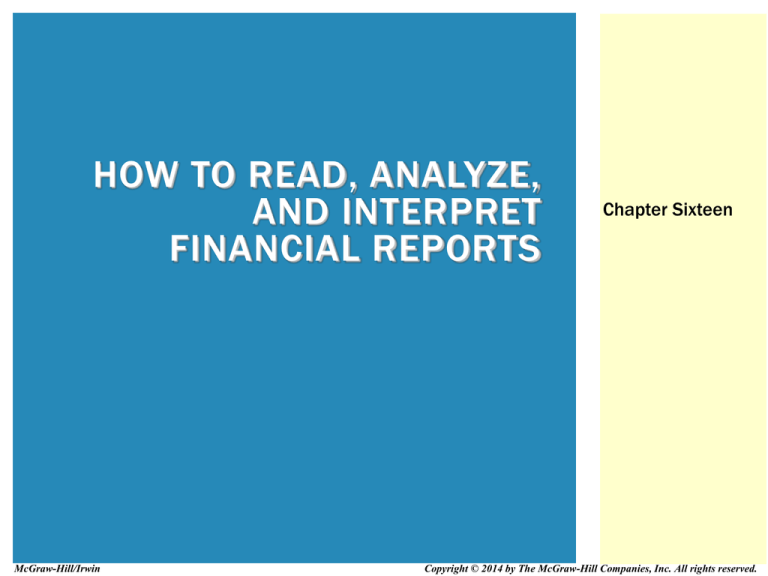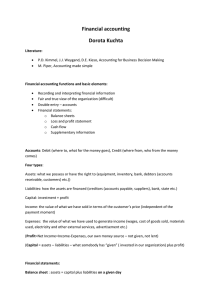
HOW TO READ, ANALYZE,
AND INTERPRET
FINANCIAL REPORTS
McGraw-Hill/Irwin
Chapter Sixteen
Copyright © 2014 by The McGraw-Hill Companies, Inc. All rights reserved.
LEARNING UNIT OBJECTIVES
LU16-1: Balance Sheet -- Report as of a Particular Date
1.
Explain the purpose and the key items on the balance sheet.
2.
Explain and complete vertical and horizontal analysis.
LU 16-1: Income Statement -- Report for a Specific Period of Time
1.
Explain the purpose and the key items on the income statement.
2.
Explain and complete vertical and horizontal analysis.
LU 16-3: Trend and Ratio Analysis
1.
Explain and complete a trend analysis.
2.
List, explain, and calculate key financial ratios.
16-2
ACCOUNTING EQUATION
Accounting Equation:
Assets = Liabilities + Owner’s Equity
16-3
BALANCE SHEET
Gives a financial picture of what a company is worth as of a particular date.
Assets
(How much the
company owns)
=
Liabilities + Owner’s Equity
(How much
the owner
is worth)
(How much
the company
owes)
16-4
ELEMENTS OF THE BALANCE SHEET
(FIGURE 16.1)
Assets broken down into
current assets and plant
and equipment
MOOL COMPANY
Balance Sheet
December 31, 2014
Assets
a. Current assets:
b. Cash
$ 7,000
c. Accounts receivable
9,000
d. Merchandise inventory
30,000
e. Prepaid expenses
15,000
f.
Total current assets
g. Plant and equipment:
h.
Building (net)
$60,000
i.
Land
84,000
j.
Total plant and equipment
k. Total assets
Total of current assets and plant and equipment.
$61,000
144,000
a.
b.
c.
d.
e.
f.
g.
a.
b.
c.
$205,000 d.
Liabilities broken down into
current and long-term
Liabilities
Current liabilities:
Accounts payable
Salaries payable
Total current liabilities
Long-term liabilities:
Mortgage note payable
Total liabilities
Stockholders’ Equity
Common stock
Retained earnings
Total stockholders’ equity
Total liab. and stkhlds’ equity
$ 80,000
12,000
$ 92,000
58,000
$150,000
$ 20,000
35,000
55,000
$205,000
Total of all liabilities and stockholders’ equity.
(Total is double-ruled)
16-5
PREPARING A VERTICAL ANALYSIS
OF A BALANCE SHEET
Step 1. Divide each asset (the portion) as a percent of total assets
(the base). Round as indicated.
Step 2. Round each liability and stockholders’ equity (the portions) as
a percent of total liabilities and stockholders’ equity (the
base). Round as indicated.
16-6
COMPARATIVE BALANCE SHEET:
VERTICAL ANALYSIS (FIGURE 16.2)
Assets
ROGER COMPANY
Comparative Balance Sheet
December 31, 2013 and 2014
2013
Amount Percent
Current Assets:
Cash
Accounts Receivable
Merchandise inventory
Prepaid rent
Total current assets
Plant and equipment:
Building (net)
Land
Total plant and equipment
Total assets
* Due to rounding
$22,000
8,000
9,000
4,000
$43,000
25.88
9.41
10.59
4.71
50.59
$18,000 21.19
24,000
28.24
$42,000
49.41*
$85,000 100.00
2014
Amount Percent
$18,000
9,000
7,000
5,000
$39,000
22.22
11.11
8.64
6.71
48.15*
$18,000
24,000
$42,000
$81,000
22.22
29.63
51.85
100.00
16-7
COMPARATIVE BALANCE SHEET:
VERTICAL ANALYSIS (FIGURE 16.2)
Liabilities
ROGER COMPANY
Comparative Balance Sheet
December 31, 2013 and 2014
2013
Amount Percent
Current liabilities:
Accounts payable
Salaries payable
Total current liabilities
Long-term liabilities:
Mortgage note payable
Total liabilities
$14,000
18,000
$32,000
16.47
21.18
37.65
$12,000
$44,000
2014
Amount Percent
$8,000
17,000
$25,000
9.88
20.99
30.86*
14.12
51.76*
$20,000
$25,000
24.69
30.86*
$20,000
23.53
21,000
24.71
$41,000
48.24
$85,000 100.00
$20,000
16,000
$36,000
$81,000
Stockholders’ Equity
Common stock
Retained earnings
Total stockholders’ equity
Total liabilities and stockholders’ equity
* Due to rounding
24.69
19.75
44.44
100.00
16-8
PREPARING A HORIZONTAL ANALYSIS
OF A COMPARATIVE BALANCE SHEET
Step 1. Calculate the increase or decrease (portion) in each item from the
base year.
Step 2. Divide the increase or decrease in Step 1 by the old or base year.
Step 3. Round as indicated.
16-9
COMPARATIVE BALANCE SHEET:
HORIZONTAL ANALYSIS (FIGURE 16.3)
ABBY ELLEN COMPANY
Comparative Balance Sheet
December 31, 2013 and 2014
Assets
Current Assets:
Cash
Accounts receivable
Merchandise inventory
Prepaid rent
Total current assets
Plant and equipment:
Building (net)
Land
Total plant and equipment
Total assets
2013
2014
Increase (decrease)
Amount Percent
$ 6,000 $ 4,000
5,000
6,000
9,000
4,000
5,000
7,000
$25,000 $21,000
$ 2,000
50.00
(1,000) -16.67
5,000 125.00
(2,000) -28.57
$ 4,000
19.05
$12,000 $12,000
18,000
18,000
$30,000 $30,000
$55,000 $51,000
0
0
0
$4,000
0
0
0
7.84
16-10
COMPARATIVE BALANCE SHEET:
HORIZONTAL ANALYSIS (FIGURE 16.3)
ABBY ELLEN COMPANY
Comparative Balance Sheet
December 31, 2013 and 2014
2013
Liabilities
Current liabilities:
Accounts payable
Salaries payable
Total current liabilities
Long-term liabilities:
Mortgage note payable
2014
$ 3,200 $ 1,800
2,900
3,200
$ 6,100
5,000
Total liabilities
Increase (decrease)
Amount Percent
$ 1,400
(300)
1,100
77.78
-9.38
22.00
17,000
15,000
2,000
13.33
$ 23,100
20,000
3,100
15.50
31,000
51,000
$ 900
$4,000
2.90
7.84
Owner’s Equity
Abby Ellen, capital
Total liabilities and owner’s equity
$31,900
$55,000
16-11
INCOME STATEMENT
Income Statement - A financial report that tells how well a
company is performing (its profitability or net profit) during a
specific period of time.
Service Business:
Retail Business:
Revenues -- Operating expenses
= Net income
Revenues (sales)
--
Cost of merchandise sold
= Gross profit from sales
--
Operating expenses
=
Net income (profit)
16-12
INCOME STATEMENT
(FIGURE 16.4)
MOOL COMPANY
Income Statement
For Month Ended December 31, 2014
Revenues
a. Gross Sales
b. Less: Sales returns and allowances
c.
Sales discounts
d. Net Sales
Cost of merchandise (goods) sold:
a. Merchandise Inventory 12/1/2014
b. Purchases
c. Less: Purchases returns and allowances
$336
d. Less: Purchase discounts
204
e. Cost of net purchases
f. Cost of merchandise (goods available for sale)
g. Less: Merchandise inventory 12/31/2014
h. Cost of merchandise (goods sold)
Gross profit from sales
Operating expenses:
a. Salary
b. Insurance
c. Utilities
d. Plumbing
e.
Rent
f. Depreciation
g.
Total operating expenses
Net income
$ 1,082
432
10,512
540
$22,080
1,514
1,248
9,972
11,220
1,600
$20,566
9,620
10,946
2,200
1.300
400
120
410
200
4,630
$ 6,316
16-13
KEY CALCULATIONS ON
INCOME STATEMENT
Net sales = Gross sales -- Sales returns allowances -- Sales discounts
Cost of
Net purchases
merchandise = Beginning +
(purchase less
-- Ending
(goods) sold
inventory
returns & discounts)
inventory
Gross profit from sales = Net sales -- Cost of merchandise (goods) sold
Net income = Gross profit -- Operating expenses
16-14
INCOME STATEMENT
VERTICAL ANALYSIS (FIGURE 16.5)
ROYAL COMPANY
Comparative Income Statement
For Years Ended December 31, 2013 and 2014
2014
Net Sales
Cost of merchandise sold
Gross profit from sales
Operating expenses:
Depreciation
Selling and Advertising
Research
Miscellaneous
Total operating expenses
Income before interest and taxes
Interest expense
Income before taxes
Provision for taxes
Net income
$45,000
19,000
$26,000
Percent
of net
100.00
42.22
57.78
$1,000
4,200
2,900
500
$8,600
$17,400
6,000
$11,400
5,500
$ 5,900
2.22
9.33
6.44
1.11
19.11*
38.67
13.33
25.33*
12.22
13.11
2013
Percent
of net
$29,000 100.00
12,000
41.38
$17,000
58.62
$
500
1,600
2,000
200
$ 4,300
$12,700
3,000
$ 9,700
3,000
$ 6,700
1.72
5.52
6.90
.69
14.83
43.79
10.34
33.45
10.34
23.10*
* Due to rounding
16-15
HORIZONTAL ANALYSIS
INCOME STATEMENT (FIGURE 16.6)
FLINT COMPANY
Comparative Income Statement
For Years Ended December 31, 2013 and 2014
2014
2013
Increase (decrease)
Amount Percent
Sale
$ 90,000 $80,000 $10,000
Sales returns and allowances
2,000
2,000
0
Net Sales $88,000
$78,000
$10,000
+ 12.82
Cost of merchandise sold
45,000
40,000
5,000
+ 12.50
Gross profit from sales $43,000
$38,000 $ 5,000
+ 13.16
Operating expenses:
Depreciation
$ 6,000
$ 5,000 $ 1,000
+ 20.00
Selling and Advertising16,000
12,000
4,000
+ 33.33
Research
600
1,000
(400)
- 40.00
Miscellaneous
1,200
500
700
+ 140.00
Total operating expenses
$23,800
$18,500 $ 5,300
+ 28.65
Income before interest and taxes $19,200
$19,500 $ (300)
- 1.54
Interest expense
4,000
4,000
0
Income before taxes
$15,200 $15,500 $ (300)
- 1.94
Provision for taxes
3,800
4,000 (200)
- 5.00
Net income $11,400
$11,500 $ (100)
.87
16-16
COMPLETING A TREND ANALYSIS
Trend Analysis –
Analyzes the changes that occur by expressing each number as a
percent of the base year.
Each Item
Base Amount
Step 1. Select the base year (100%).
Step 2. Express each amount as a percent of the base year amount
(rounded to the nearest whole percent).
16-17
TREND ANALYSIS
Sales
2015
2014
$621,000
Gross Profit
Net Income
2015
Sales* 148%
Gross Profit
Net Income
Given (base year 2012)
2013
2012
$460,000
$340,000
182,000
48,000
2014
110%
147
126
2013
81%
114
108
* Round to nearest whole percent
141,000
41,000
$420,000
112,000
22,000
124,000
38,000
Trend Analysis
2012
100%
90
100
58
100
$340,000
$420,000
16-18




